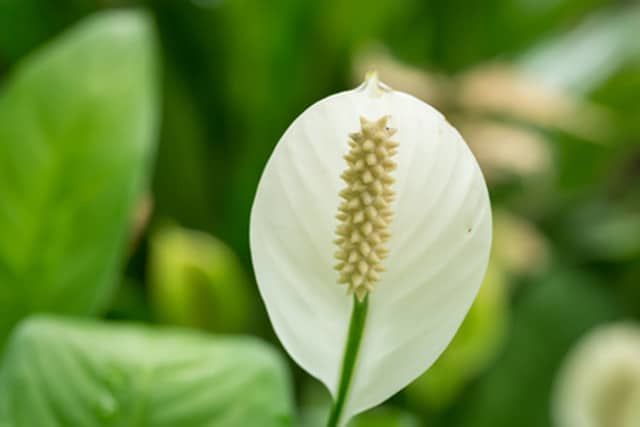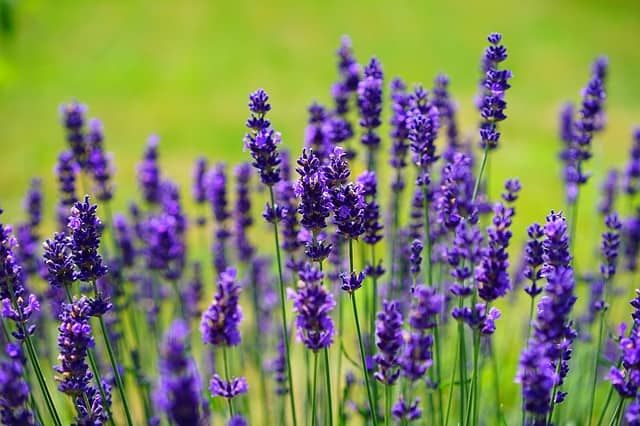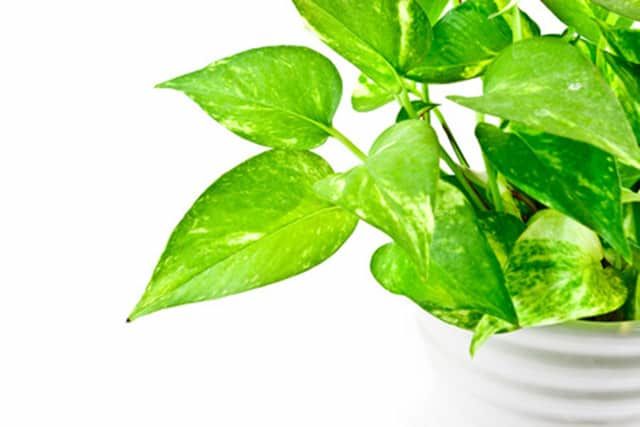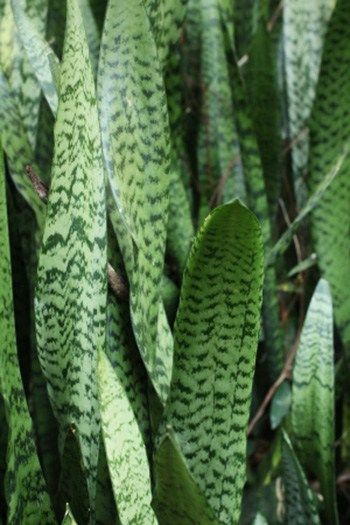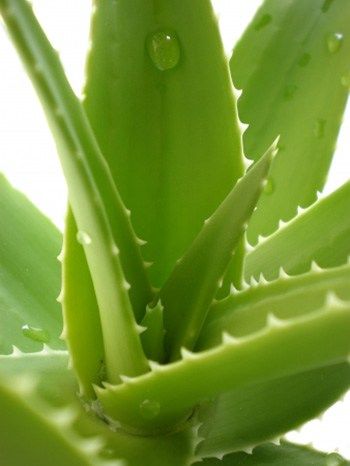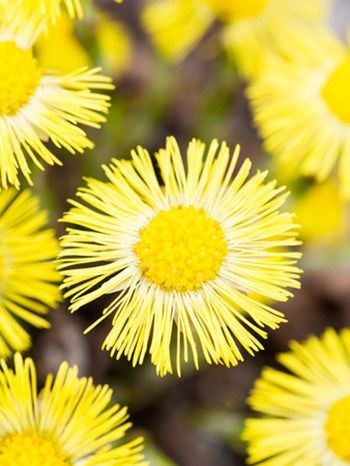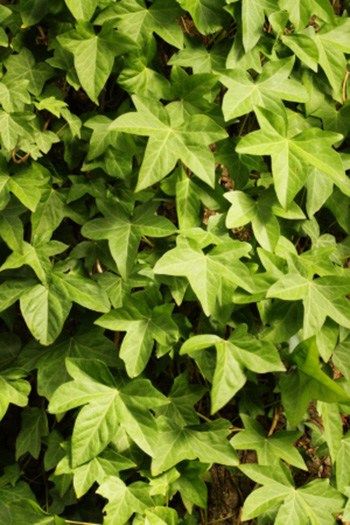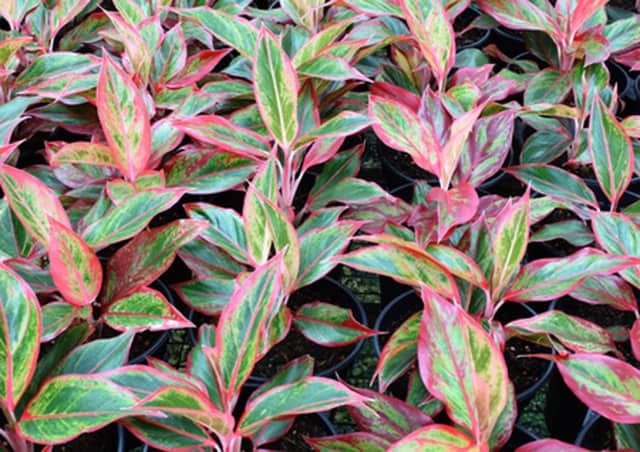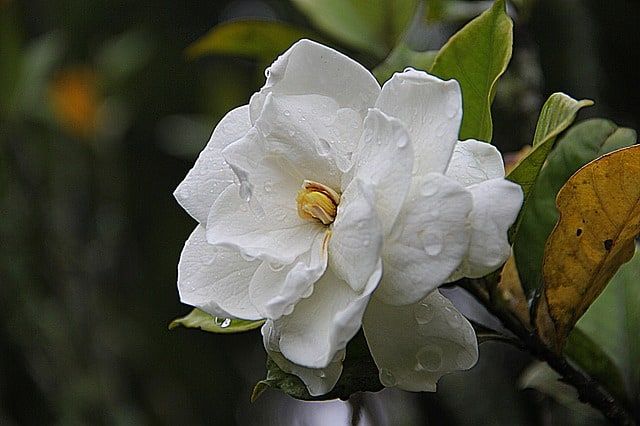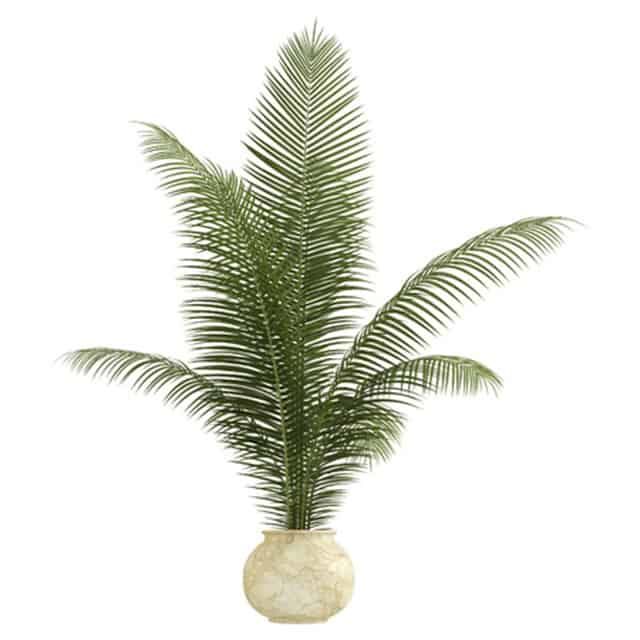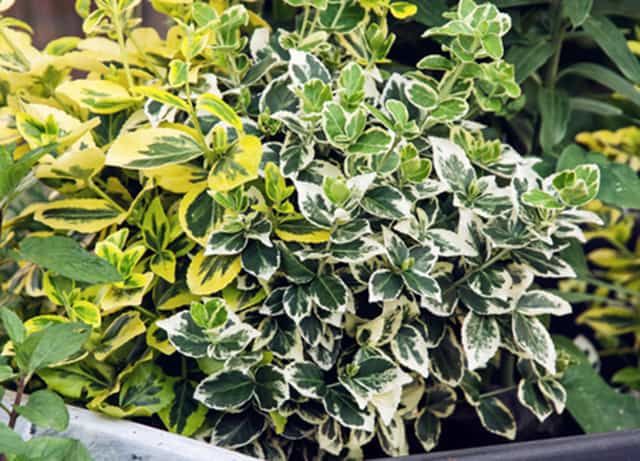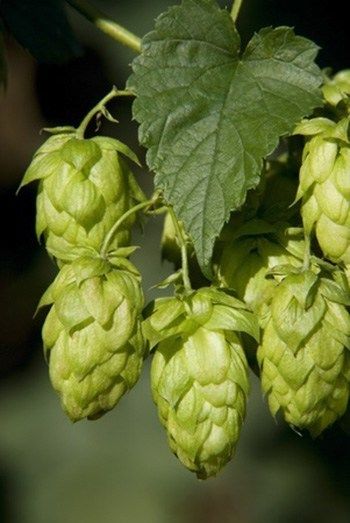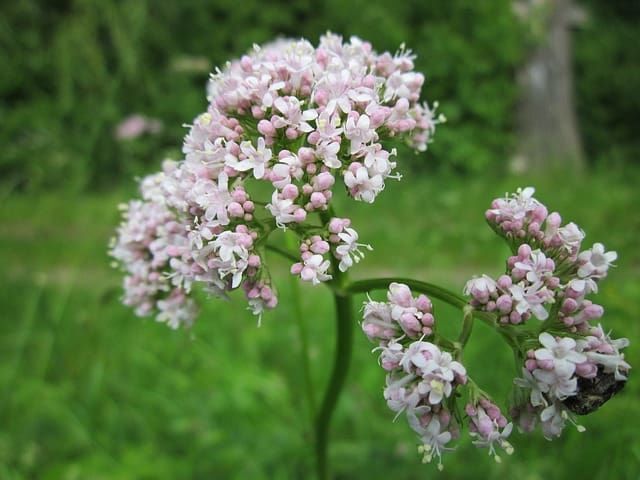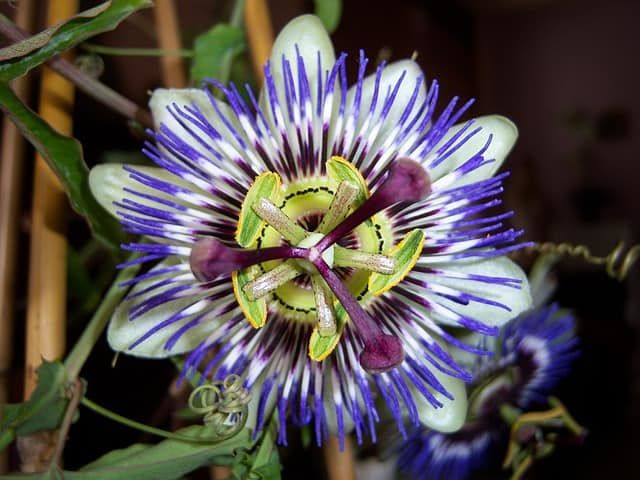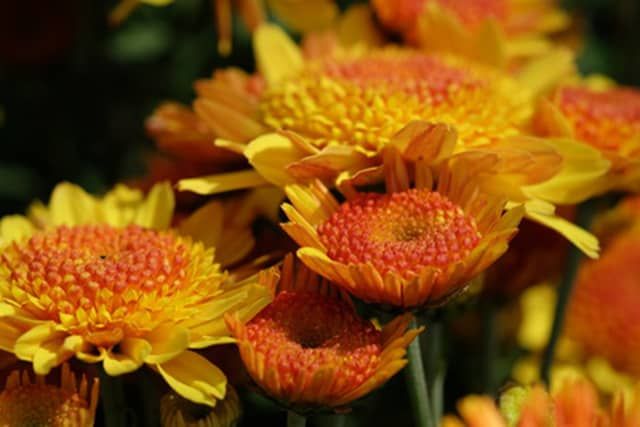Don’t you just hate it when you wake up from a terrible sleep feeling groggy and tired, and you still have to go about your days’ work? One bizarre trick that you can use is to have plants for your bedroom that will help increase the quality of your sleep.
So to help you out, here are 23 of the best plants for the bedroom to help you sleep like a baby.
You may be interested in: Get the Inside Scoop on Sleep Inducing Foods
#1 Peace Out Peace Lily
Peace Lilies are so effective that it was rated as one of the best indoor plants to remove air pollution by NASA. The elegant white flowers as well as the dark green leaves gives a stylish feeling to the room.
They’re excellent at cleansing the air, as they breakdown and neutralize harmful gases that are floating around the house: particularly benzene, formaldehyde, and carbon monoxide. The Peace Lily uses a plant-judo move where it takes the mould spores floating about and absorbs them through its leaves, only to use the spores as food for the plant. This increases the quality of the air which will help prevent any diseases caused by air pollution while you’re sleeping.
The Peace Lily grows depending on the amount of light it’s subjected to. Generally, it requires medium, indirect light; the more light it’s exposed to, the more white flowers it’ll produce. Many people overwater the Peace Lily, which is one of the most common reasons for its death. You can either water it when the soil is dry or you can wait for the plant to start drooping, an easy indicator to tell whether it’s thirsty or not.
#2 French Lavender At Your Service
You’ve probably heard of Lavender extracts used in essential oils before. It’s a low maintenance plant with a sophisticated purple color and emits a pleasant fragrance, making it a perfect-fit if you want a plant that takes care of itself with a little check up every now and then.
Lavender is commonly known for its relaxant properties – helping those who suffer from insomnia, restlessness and similar conditions, which makes it a perfect plant to induce sleep.
Others have said that it aids with painful conditions such as headaches, toothaches, and joint pain. Research has shown that the benefits of Lavender can be received when its scent is inhaled, and because of its gorgeous purple color, it’s perfect for the bedroom for its decorative and sleep-inducing benefits.
Unlike the Peace Lily, Lavender benefits from direct sunlight, so place it near a window or under a grow light if possible. They’re extremely easy to maintain once they’re up and running because they do well without watering; the fragrance and flower will grow the best under dry conditions, so make sure not to saturate them.
#3 Golden Pothos – The Clean Air Superhero
Golden Pothos are one of the most popular types of houseplants because it removes the toxins from air, it has a stylish look and it’s extremely easy to maintain; just a little water here and there and you’re good to go. Some people even go as far to throw a few cuttings from the Golden Pothos into a jug and allow them to work its magic. They grow thin vines and it produces bright leaves that are green with sporadic spots of yellow.
This is another one of those plants that specializes in removing harmful toxins from the air, specifically carbon monoxide and formaldehyde, which improves the quality of the air to help you get a better sleep at night.
Unlike other plants that require indirect and bright light, Golden Pothos can grow in low light areas as well. When watering it, make sure that the soil is completely dry before watering it again to avoid root rot. One thing to worry about is that Pothos can be poisonous if eaten, so if you have pets or children in the house you want to make sure that it’s in a place that they can’t reach.
#4 The Sneaky Snake Plant
The Snake Plant produces tall, stiff green leaves with a trim of yellow running along the outside. They’re definitely not a plant that can be hidden away due to the length and nature of the leaves, however they add a liveliness to the room, and because they’re easy to maintain, they’re perfect for the bedroom.
The Snake Plant (also known as Mother-in-Law’s Tongue) is packed with properties that improve the quality of the air which makes it one of the best houseplants for bedroom use. It helps to remove toxins from the air, specifically formaldehyde, trichloroethylene, xylene, toluene, and benzene. Another key benefit of the Snake Plant is that it has a Plant-Judo move, similar to the Peace Lily, where it transforms carbon dioxide into oxygen at night.
This point plant is also relatively cheap and doesn’t need much attention to receive the benefits from it. To care for this plant, place it in an area that receives indirect sunlight and water it sparingly; the most common mistake that people make with the Snake plant is that they continuously water it, which makes it easily susceptible to rotting.
#5 Spiderman’s Favorite: Spider Plant
It’s your friendly neighbourhood Spider Plant! I guess they chose that nickname because the leaves look similar to that of a spider’s legs – long, dangly, and lots of them.
The spider plant is another one of those low-maintenance but high-reward plants that are great at improving the quality of the air. This plant goes toe-to-toe with the harmful chemicals like benzene, formaldehyde, carbon monoxide, and xylen; chemicals which have shown to cause headaches and brain fog.
Spider plants don’t need your attention in order for them to grow, making them perfect if you’re new to plants and can’t be bothered with the hassle of constant care. The only things that Spider Plants require is well-drained soil and bright, indirect light. Make sure to not overwater them to avoid root-rot, another main reason why Spider Plants die. Even though they don’t require much attention, they do prefer to be in cooler temperatures (anywhere from 55 to 65 F).
#6 The All-Rounder Aloe Vera
Ye’ Old Aloe Vera plant. Aloe Vera contains so many beneficial properties that it can be found in almost any form including juice, gel, tea, cream, tablets, toothpastes, even yoghurts!
It contains multiple vitamins and minerals that aid the overall health of the body. It’s a spiky, cactus-like plant that has been around for hundreds of years, with research showing that even the Egyptian queen Cleopatra using it as part of her beauty treatment.
The majority of people use it specifically for its skin-healing properties, commonly being used to help heal cuts and wounds. However, most people don’t know that it also helps with improving the quality of your sleep! This is because Aloe Vera helps to fight the harmful toxins that float around, helping improve the quality of the air whilst you sleep (also NASA approved).
Fortunately, she’s one of those plants that requires little work and you can still reap the benefits that it has to offer. There are two main reasons why Aloe Vera plants die: either they get watered too often, or they don’t have room for the water to drain from the soil. Avoid these two problems, and you’re all set.
#7 The Counter To Air Bacteria – Elecampane
Elecampane (also known as Inula helenium) is a daisy-like plant with long stems and skinny yellow petals, growing anywhere from 3 to 6 feet. They can be found in the southern and central parts of Europe as well as in Great Britain and Asia. Elecampane is known for its medicinal properties, especially aiding in the treatment of lung diseases such as asthma and bronchitis.
The use of Elecampane for its medicinal properties go all the way back to the 19th century, where any lozenges/cough lollies were produced from the root of the Elecampane. It’s especially beneficial because there are chemicals in the root that help to prevent any respiratory diseases which can occur if excessive amounts of polluted air is inhaled.
One particular study showed that Elecampane was 100% effective against 200 staphylococci (common types of bacteria) including Methicillin-resistant Staphylococcus Aureus (MRSA), a type of bacteria that is a major cause for many infections.
Full to partial sunlight is best for this plant, with ordinary soil and regular watering in summer so the soil stays moist but not overwatered.
#8 English Ivy – No, They’re Not Weeds.
You’ve probably mistaken English Ivy for weeds at some point, due to their vine-like nature and how they scatter across surfaces. English Ivy attaches itself to anything it can. It originates from Europe, Northern Africa and Western Asia, and was first introduced by European Colonists in the 18th Century. You can usually find them on brick walls, climbing up the tree trunks, and invading various vegetation areas.
English Ivy has shown properties that help fight against mold floating in the air. Mold allergies can become a huge problem from your body, starting out with rashes, coughing, or itching and eventually leading to illnesses like fever and chest pain. One particular study tested the effectiveness of English Ivy against moldy bread and dog faeces. After twelve hours, the quality of the air in the moldy bread container showed a 78% drop in air toxins whilst the dog faeces container had a 94% drop!
To grow this clingy sucker in your home, you can put it in a pot plant and, if they’re not developed fully, water them so that the soil is consistently moist (not drenched) until the plant is fully developed. Once they’re grown up, they can withstand dry environments and don’t need much maintenance.
#9 The Toughest Houseplant Of All – Chinese Evergreen
Another one on the list that’s perfect for plant-newbies who want low-maintenance plants that still give great benefits.
Chinese Evergreen is one of the more popular houseplants because it can withstand multiple environmental conditions (no water, no light, low levels of humidity) better than the majority of other house plants. They have long, pointy dark-green leaves with patterns of white, grey and cream throughout the leaves, which give it a distinctive look, and they usually grow anywhere from 2 to 3 feet.
Chinese Evergreen plants help you sleep because they’re effective at cleaning the air that’s riddle with air pollutants and toxins. These toxins can cause a number of diseases and harm your respiratory system, so it’s important to have clean air to prevent these illnesses and help you sleep at night.
Even though they can withstand harsh conditions, they prefer to sit in indirect sunlight and temperatures no lower than 60 degree F. They also prefer well-drained soil and moderate amounts of water, making sure to not drench it and cause root rot.
#10 Sage Is Here To Help You Sleep
Sage has been used for hundreds of years, not only for the flavor that it brings, but also because of its medicinal properties. It leaves are coloured green with a hint of grey, and they’re commonly used in meals (especially towards Thanksgiving time), as well as in teas and essential oils. Sage is so popular and well-known, that even the Greeks and Romans used it for its medicinal properties, including in the treatment of ulcers.
Sage is said to help with the overall health of the body, and also helps to prevent cognitive diseases, inflammatory problems, skin conditions, digestive problems, and many more. Many people have also claimed that sage acts as a sedative, which will help you to fall asleep faster. However, it can be a little too relaxing if taken in conjunction with a sedative drug, so be careful in those circumstances.
It’s important to remember that when you’re growing Sage indoors, they require lots of light so place them next to a sunny window or you can use fluorescent lighting to help the process. Water the plant when necessary. If the top of the soil is still moist, let it dry out before watering it again.
#11 Angel-Like Gardenia
Another plant that produces smooth leaves with white, elegant, glossy flowers that emit a specific fragrance; a perfect addition to any bedroom that needs a little bit more “oomph”. Gardenia plants are native to Asia, Africa, and the Pacific Islands. They’re relatively compact plants, growing anywhere from 2 to 8 feet tall, and extracts of the Gardenia are commonly used in essential oils and tea.
Gardenia is particularly useful due to its antioxidant, antibacterial and anti-inflammatory properties. It’s also commonly used for its natural sedative-purposes, which will help you fall asleep faster. One study showed that one of the carotenoids found in Gardenia, called Crocetin, improved the sleep quality of 21 men that suffered from problems associated with sleep, with no additional side effects.
Growing Gardenia requires bright, indirect light and high humidity levels. The indicator that the humidity levels aren’t high enough is when the flowers begin to droop. To fix this, you can spray them with water regularly. Water them regularly to keep the soil moist, but making sure not to overwater them.
#12 Areca Palm – The Tropical Air-Cleaner
Areca Palm is one of the easier palm trees to grow indoors. It’s relatively tall, growing anywhere from 6 to 7 feet, so it’s definitely a plant that stands out of the crowd and draws attention. Areca Palm plants have yellow/greenish leaves and will add a tropical feel to your home; they look like a miniature version of the palm trees you may have seen on the side of the roads in Beverly Hills.
The Areca Palm is one of the most efficient plants at purifying the air. It has the ability to remove harmful toxins from the air, preventing any air-pollution related diseases while you sleep. They’re also known as one of the most effective natural air humidifiers.
This plant requires bright, indirect light – the more direct the light intensity is, the more yellow the leaves will be. They require regular watering in spring and summer so the soil is kept moist, but in winter and autumn you can allow it to dry between watering sessions.
#13 Ficus Benjamina – It’s Like A Normal Tree, Just Smaller
If you’re not a fan of exotic palm trees that demand attention, or plants that produce daisy-like flowers, and you’re just looking for a normal tree with dark green leaves and a single trunk that helps improve air quality – Ficus Benjamina (also known as Weeping Fig tree) could be exactly what you’re looking for.
Ficus Benjamina is an air-pollutant combatant that excels specifically at fighting the toxins formaldehyde, benzene and trichloroethylene. One study conducted by the Department of Crop Science showed that the Ficus Benjamina extracts contained significant amounts of antioxidants and also showed antimicrobial activity, suggesting that it also holds antimicrobial agents.
To grow Ficus Benjamina indoors, it requires bright and indirect light as well as temperatures above 70 degrees F. They also prefer high humidity levels and moist soil, so water them regularly but being careful not to overwater them to avoid root rot. The leaves can begin to droop; this is an indicator that the Weeping Fig tree is stressed and it requires a bit more attention. This can happen for a number of reasons including low humidity levels, not enough light, and watering them too much or too little.
#14 Nope. It’s Not Corn, It’s Calamus
I’m not gonna lie – the first time I saw this plant, I mistook it for a piece of Corn.
Different types of Calamus (also known as Sweet Flag) can be found in Japan, China, Europe, Australia, and the northern parts of USA. It’s commonly known for its medicinal properties, aiding in the treatment of Asthma, Colds, Headaches, Insomnia, and other sicknesses. It can be extracted into tea, as well as used as a bath additive or alcohol rub.
In Traditional Chinese Medicine, Calamus is used to combat illnesses such as dizziness, epilepsy, and abdominal pain. In folk medicine, it was used to calm the nerves of the patient, this is because of the effect sedative effect of the main component of Calamus Oil, called Cis-Isoasarone.
Calamus bloom towards summertime, grow anywhere from 3 to 6 feet, and prefers moderate to full sunlight. You’ll most likely find Calamus in Water Gardens as they prefer moist soil, so make sure that if you get a Calamus plant, you regularly water it.
#15 Hop Cones (Not Waffle Cones)
If there was a plant that improved the quality of your sleep whilst sprouting waffle clones, that’d be awesome too. Unfortunately, this plant doesn’t do that.
Hop Plants produces Hop Cones, and Hop Cones are commonly used to flavor beers alongside with fruits and spices. They can grow in any moderate climate as long as they’re cared for and properly looked after, and they’re most commonly found in USA, Asia, England, New Zealand, Australia, and Germany.
Many Hop Pickers have reported feeling slightly sedated during the picking of Hop Cones, which is why it can be effective for sleep-inducement; they’re most commonly used in combination with Valerian to combat insomnia. There’s a chemical in Hops that induces sleep called Methylbutenol, making it an effective addition to your bedroom. Multiple studies have shown the effectiveness that Hops has in conjunction with Valerian – the majority coming to the conclusion that Hops can be used as an effective sleeping agent.
Hops require lots of sunlight and water, so place them in an area that receives plenty of sun and when it gets extremely hot, it may require water on a daily basis. They also prefer well-drained, rich soil to grow to its fullest potential.
#16 The Common Chamomile
If you’ve come across Chamomile, it was most likely in one of your last cups of teas.
Chamomile are actually a group of daisy-like plants that have long stems that bloom white flowers with yellow centres, which make them a common addition to gardens and lawns due to its decorative and attractive appearance.
The two most common types of Chamomile are Roman Chamomile and German Chamomile; the main difference between the two is that Roman Chamomile are much smaller than German Chamomile which can grow up to 1-2 feet tall.
Chamomile is an ancient herbal remedy that isn’t anything new to the world – it was commonly used in Egypt, Greece and Rome for medicinal purposes.
The Chamomile has been used to induce sleep for a number of years. The main reason it helps with sleep is because of its ability to sedate the user, which is due to the flavonoids. One study showed the effect that chamomile tea has on patients with cardiac disease. They reported they ten of the twelve patients went into a deep sleep after drinking the tea.
If you’re growing Chamomile, it grows best in cool environments and under shade (with that being said, it still grows in direct sun) and in dry soil. Once it’s grown, it needs little watering and fertilizing.
#17 When In Doubt, Rosehip It Out
I can fully understand if you mistake these for cherry tomatoes, its color and size makes it look like you just want to throw them in a chicken salad with some iceberg lettuce.
Rosehips are the fruits that spawn from certain rose bushes, most notably the Wild Dog Rose. They contains the seeds of the rose plants, and they contain high amounts of Vitamin C (50% higher than oranges), making them excellent at improving the health of your immune system. This probably isn’t the first time you’ve seen rosehips – they’re most commonly used in tea, jams, sauces, and soups.
Rosehips also contain properties that are beneficial for the body other than having high amounts of Vitamin C – many people use it as a laxative because it is shown to relieve kidney disorders and constipation. It’s also contains antioxidants, specifically carotenoids, polyphenols, and flavonoids. These antioxidants have shown to help against preventing cancer and cardiovascular diseases, as well as the flavonoids aiding with sleep quality.
#18 The Well-Known Valerian
You may have heard of this one before as well – Valerian extract is commonly used in food and beverages as a flavor, as well as making tea from the root of Valerian. Valerian’s long plant stalks and colorful flowers, generally white or pink, are tight and compact which make it a wonderful addition to the bedroom since it doesn’t take up much space whilst you reap the benefits it has to offer.
Valerian is most commonly known for its sleep-inducing properties, as it helps with relaxing the muscles and central nervous system – making it a perfect herb to incorporate into your bedroom décor. The sleep-effect comes from a number of chemicals found in Valerian, specifically isovaleric acid and valepotriates. One study showed the positive effect that Valerian has on sleep efficiency, and ultimately came to the conclusion that Valerian extract can be used to benefit the quality of your sleep, especially for those who suffer from insomnia.
Allow the Valerian to find a spot that receives a lot of sunlight, as well as watering it enough to moisten the soil, making sure not to overwater it.
#19 The Glamorous Passion Flower
Just like the Gerbera Daisies, if you’re wanting to add some bright color to your bedroom, the Passion Flower is for you. The Passion flower was discovered in 1569 by Spanish Jesuits that saw the flower as a symbol of Christ’s’ passion. The flower can come in number of colors including blue, purple, red, white, and yellow.
But this isn’t just a plant that’ll add some liveliness to your room, the Passion Flower is known for a common counter to sleep problems that are related to anxiety or nervousness, specifically Gastrointestinal Upset and Insomnia. One studyshowed the effectiveness of Passion Flower extract against Oxazepam (a drug that’s used to relieve anxiety). The results showed that the Passion Flower extract was as effective as Oxazepam in relieving anxiety with the advantage that it didn’t hinder job performance of the participants (something that Oxazepam users suffered from).
Passion flowers require full sunlight and well-drained soil – for this reason they’re usually grown outside along a fence. But since we’re using this plant to induce-sleep, you can just let the Passion flower sit next to a window with direct light.
#20 Another Renowned One For The List– Jasmine
No, we’re not talking about the princess from Aladdin.
The Jasmine plant is a common plant that’s well known for the tiny flowers that it produces, usually coming in either white or yellow. Its fragrance is a distinct smell that’s usually used in perfumes and essential oils. It is found in forest, valleys, and ravines in the Himalayas and western china.
Jasmine is effective as a sleeping-agent specifically because of its sweet fragrance. Multiple findings have found that sleeping in a room with Jasmine helps to induce sleep. One particular study showed the effect fragrance-filled rooms has on sleep quality: one fragranced with Jasmine, another with lavender, and the last was left normal as a control group. The studies found that those who slept in Jasmine had a better quality of sleep, woke up feeling more refreshed and had more energy the next day in comparison to the other two.
To care for indoor Jasmine plants, it’s best to let them get direct sunlight during summer and spring. When winter rolls around, the sunlight doesn’t have to be direct. Watering is simple – just water it till the soil is moist.
#21 You’re In Safe Hands With Bamboo Palm
Don’t worry, this type of Palm Tree isn’t tall enough to bust a hole through your roof. Bamboo Palm only grows between 4 and 12 feet, and is one of the low-maintenance plants that riddles the air of the two harmful chemicals benzene and trichloroethylene. The Bamboo Palm will bring a tropical look to your bedroom that’ll improve the quality of the air while you sleep. This is another plant that was “NASA-Certified” as a plant that fights air pollution.
When buying a Bamboo Palm plant, make sure that it’s healthy and has dark green leaves; this will make the growing process much easier. Bamboo palm is different from other variations of palm trees in the sense that it doesn’t require bright light for it to grow – the bamboo palm can grow in low lit areas, however the more indirect and bright light it receives, the larger it will grow. Watering it is simple – whenever the soil feels dry, water it evenly so all of the soil is moist while making sure not to overwater it.
#22 For You Bright-Color Lovers, Gerbera Daisies Are For you
If you’re looking for a plant that grows beautiful, joyful flowers that come in a number of different colours, then the Gerbera Daisies are for you. The flowers come in a number of bright colours including white, purple, pink, orange, and yellow. They’re definitely the type of flower that you won’t be scared to show off to your friends and family.
Gerbera Daisies are another plant that’s recommended by NASA to clean the air from pollution. They’re specifically helpful for sleep because it releases oxygen at night, whereas most other plants release oxygen during the day. For this reason, it also is said to be helpful if you’re suffering from breathing-related illnesses. It also helps with the “waking-up” process; Harvard research has found that flowers help you to feel happier in the morning as you’re waking up.
To care for Gerbera Daisies, they require full, direct sunlight and sandy soil. When they’re growing, water them regularly but as the flowers begin to bloom you can slow down on the watering to avoid rotting. The best time to water them is in the morning so that the leaves have time to dry out, therefore avoiding any risk of the plants rotting.
#23 And Last But Not Least, Boston Fern
The Boston Fern produces droopy, green ferns that add style to the room due to its unkempt look as it drapes over a pot or basket. They’re relatively easy to maintain, and studies have shown that it’s a reliable air-pollution combatant, specifically against the toxin formaldehyde – this will help to improve the quality of the air as you sleep so that you aren’t prone to any sicknesses caused by air pollution.
Boston Fern aren’t as easy as the other plants; this one requires a bit more attention. This plant needs to be placed in a spot with indirect sunlight – if the fern is placed in direct sunlight, you run the risk of drying out the ferns. They also need to be placed somewhere with high humidity – to help with this, you can sit the pot on a tray of pebbles with water as well as lighting spraying the ferns with water. One way that the fern indicates it needs more humidity is if the ferns start turning a yellow colour.
As with the other plants, they do need regular watering, but not too much so that you avoid rotting the plant.
Feel Free To Ask!
And that’s it! There definitely aren’t a lack of plants that can be used to aid you in your sleep. Some help relax your body, others help clean the air of any toxins that are floating around so that you’re not breathing in harmful chemicals as you sleep. Did you enjoy the list? Share it with any of your friends that’ll benefit from it, and if you know of any other plants that help with sleep, feel free to comment below.
